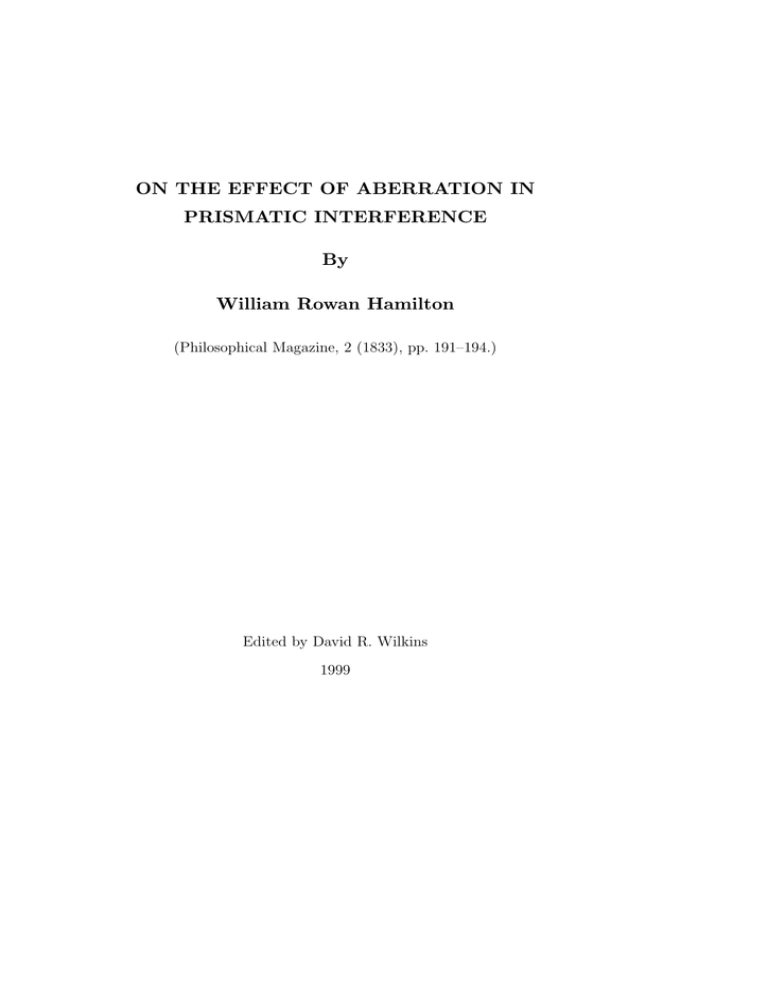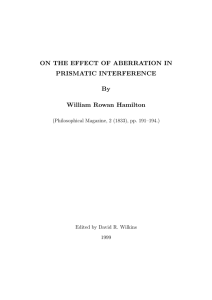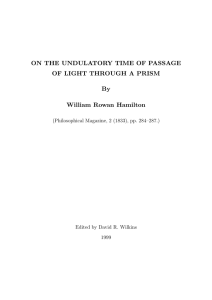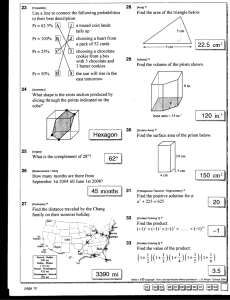ON THE EFFECT OF ABERRATION IN PRISMATIC INTERFERENCE By William Rowan Hamilton
advertisement

ON THE EFFECT OF ABERRATION IN PRISMATIC INTERFERENCE By William Rowan Hamilton (Philosophical Magazine, 2 (1833), pp. 191–194.) Edited by David R. Wilkins 1999 On the Effect of Aberration in prismatic Interference. By William R. Hamilton, Esq. Andrews’ Professor of Astronomy in the University of Dublin, and Royal Astronomer of Ireland *. [The London and Edinburgh Philosophical Magazine and Journal of Science, vol. ii (1833), pp. 191–194.] The experiments and reasonings of Mr. Potter respecting the phænomena of prismatic interference, published in the last Number of the London and Edinburgh Philosophical Magazine (for February 1833), deserve attention; for, if correct, they would furnish a formidable and, perhaps, fatal objection against the undulatory theory of light. I have not repeated the experiments, but have endeavoured to examine the mathematical part of the question, and have obtained results which differ from the mathematical results of Mr. Potter, and which appear to show that the phænomena described by him are consistent with the undulatory theory. It may, therefore, be useful to state briefly some of my results, in a form adapted for comparison with those of which they profess to be corrections. In stating them, it cannot be supposed that I intend any personal attack on Mr. Potter, for whose talents and industry I feel a sincere respect. Mr. Potter believes it to be a mathematical consequence of the undulatory theory of light, that when rays, in a plane perpendicular to the edge of a prism of glass, diverge from a luminous point in vacuo, and emerge from the prism after refraction, into a vacuum again, the locus of the points simultaneously attained by the emergent light is a circle;—either rigorously, or at least with an accuracy sufficient for the investigation of the positions of the central points of interference of two emergent streams of homogeneous light, which had set out together from two near luminous origins, namely, from the images of a luminous point formed by two plane mirrors inclined at a small angle to each other:—from which he concludes that these central points of interference, in a given plane perpendicular to the edge, are situated on a certain hyperbola, tending towards the angle of the prism, whereas he found by experiment a tendency from that angle. I find, however, that in consequence of the prismatic aberration (which is greater than the aberration of a lens), the section of an emergent wave differs sensibly from the circular form, and the time of arrival of the light at any proposed point of interference requires a sensible correction; by allowing for which I find, as the locus of the points of central interference in the plane perpendicular to the edge, a curve not hyperbolic, and not tending towards but from the angle of the prism: so that the phænomenon observed by Mr. Potter is a consequence of the undulatory theory. To simplify the question I shall suppose, with him, that the line joining the two near luminous origins is perpendicularly bisected by a line which, if considered as an incident ray, would undergo the minimum of deviation, and would emerge in a certain direction, which I shall take, as he does, for the axis of x; supposing also, with him, that this emergent line * Communicated by the Author. 1 passes through, or very near the edge, and measuring the positive ordinates y towards the thickness of the prism, while the positive abscissæ x are measured from the incident towards the emergent light. The problem is then to find, at least approximately, the equation in x, y, of the locus of points of central interference, or of simultaneous arrival of the light from the two luminous origins, with the undulatory law of velocity; and, in particular, to examine whether this locus tends to or from the angle of the prism, by examining whether the ordinate y decreases or increases, while the abscissa x increases from its value at the prism. Denoting, as Mr. Potter does, the coordinates of the prismatic focus or image corresponding to one luminous origin by the values x = ma, y = a, and those of the prismatic image of the other luminous origin by x = 0, y = −a, in which a is half the interval between the two near luminous origins, and m is a positive number depending on the angle and index of the prism, Mr. Potter finds for the difference of times of arrival of the two streams of emergent light at any point x, y, not far from the axis of x, the expression p p x2 + (y + a)2 − (x − ma)2 + (y − a)2 − ma, (1) and equating this expression to zero, he finds for the locus of the points of central interference, the equation of a common hyperbola, which may be put under the following approximate form, ma2 . (2) y= 4x If then this analysis were sufficient, it would show, as Mr. Potter has concluded, that y decreases, and that the locus tends towards the angle of the prism; whereas the experiment showed a contrary tendency. But I find, that on account of the prismatic aberration, the expression (1) for the difference of times of arrival, requires this correction, namely, ml 4 y+a x 3 ml − 4 y−a x 3 , (3) in which l is a positive quantity, namely, the length of the path traversed by the light in arriving at the edge of the prism; and after allowing for this correction (3), the equation of the sought locus, of the points of central interference, gives the following approximate expression for the ordinate y, ma2 ma2 l y= − , (4) 4x 4x2 2 the second term being introduced by aberration, but being of the same order as the first. And taking account of this new term in the expression of the ordinate, we have, by differentiation, ma2 ma2 l ma2 (2l − x) dy =− + = , dx 4x 2x3 4x3 (5) so that while x increases from its value l at the prism to the value 2l, the ordinate y increases ma2 from 0 to , and the curve tends towards the thickness of the prism, as it was found in the 16 . l experiment to do. Indeed, when x increases still further, that is, when the eye is withdrawn from the prism to a distance greater than the length of the incident path, that is, greater than the distance of the prism from the two near luminous origins, the curve begins to tend the other way, though much more slowly; but the experiments of Mr. Potter do not seem to have been made at so great a distance from the prism, and therefore the phænomenon, which he observed, appears to be explained by the undulatory theory. Dublin Observatory, Feb. 12, 1833. 3






